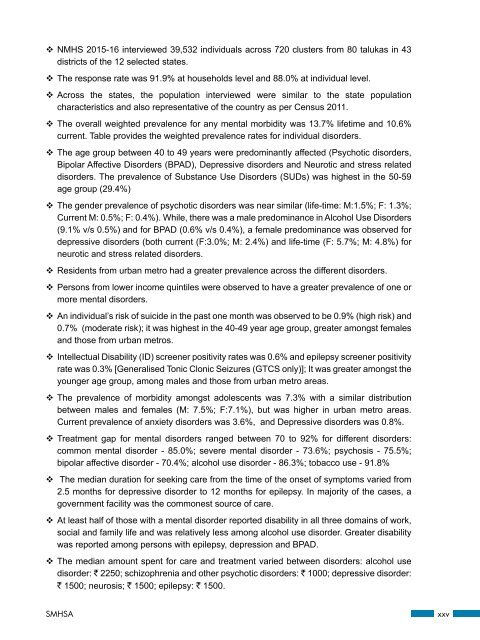National Mental Health Survey of India 2015-16
NMHS%20Report%20%28Mental%20Health%20Systems%29%201
NMHS%20Report%20%28Mental%20Health%20Systems%29%201
Create successful ePaper yourself
Turn your PDF publications into a flip-book with our unique Google optimized e-Paper software.
NMHS <strong>2015</strong>-<strong>16</strong> interviewed 39,532 individuals across 720 clusters from 80 talukas in 43<br />
districts <strong>of</strong> the 12 selected states.<br />
The response rate was 91.9% at households level and 88.0% at individual level.<br />
Across the states, the population interviewed were similar to the state population<br />
characteristics and also representative <strong>of</strong> the country as per Census 2011.<br />
The overall weighted prevalence for any mental morbidity was 13.7% lifetime and 10.6%<br />
current. Table provides the weighted prevalence rates for individual disorders.<br />
The age group between 40 to 49 years were predominantly affected (Psychotic disorders,<br />
Bipolar Affective Disorders (BPAD), Depressive disorders and Neurotic and stress related<br />
disorders. The prevalence <strong>of</strong> Substance Use Disorders (SUDs) was highest in the 50-59<br />
age group (29.4%)<br />
The gender prevalence <strong>of</strong> psychotic disorders was near similar (life-time: M:1.5%; F: 1.3%;<br />
Current M: 0.5%; F: 0.4%). While, there was a male predominance in Alcohol Use Disorders<br />
(9.1% v/s 0.5%) and for BPAD (0.6% v/s 0.4%), a female predominance was observed for<br />
depressive disorders (both current (F:3.0%; M: 2.4%) and life-time (F: 5.7%; M: 4.8%) for<br />
neurotic and stress related disorders.<br />
Residents from urban metro had a greater prevalence across the different disorders.<br />
Persons from lower income quintiles were observed to have a greater prevalence <strong>of</strong> one or<br />
more mental disorders.<br />
An individual’s risk <strong>of</strong> suicide in the past one month was observed to be 0.9% (high risk) and<br />
0.7% (moderate risk); it was highest in the 40-49 year age group, greater amongst females<br />
and those from urban metros.<br />
Intellectual Disability (ID) screener positivity rates was 0.6% and epilepsy screener positivity<br />
rate was 0.3% [Generalised Tonic Clonic Seizures (GTCS only)]; It was greater amongst the<br />
younger age group, among males and those from urban metro areas.<br />
The prevalence <strong>of</strong> morbidity amongst adolescents was 7.3% with a similar distribution<br />
between males and females (M: 7.5%; F:7.1%), but was higher in urban metro areas.<br />
Current prevalence <strong>of</strong> anxiety disorders was 3.6%, and Depressive disorders was 0.8%.<br />
Treatment gap for mental disorders ranged between 70 to 92% for different disorders:<br />
common mental disorder - 85.0%; severe mental disorder - 73.6%; psychosis - 75.5%;<br />
bipolar affective disorder - 70.4%; alcohol use disorder - 86.3%; tobacco use - 91.8%<br />
The median duration for seeking care from the time <strong>of</strong> the onset <strong>of</strong> symptoms varied from<br />
2.5 months for depressive disorder to 12 months for epilepsy. In majority <strong>of</strong> the cases, a<br />
government facility was the commonest source <strong>of</strong> care.<br />
At least half <strong>of</strong> those with a mental disorder reported disability in all three domains <strong>of</strong> work,<br />
social and family life and was relatively less among alcohol use disorder. Greater disability<br />
was reported among persons with epilepsy, depression and BPAD.<br />
The median amount spent for care and treatment varied between disorders: alcohol use<br />
disorder: ` 2250; schizophrenia and other psychotic disorders: ` 1000; depressive disorder:<br />
` 1500; neurosis; ` 1500; epilepsy: ` 1500.<br />
SMHSA<br />
xxv


